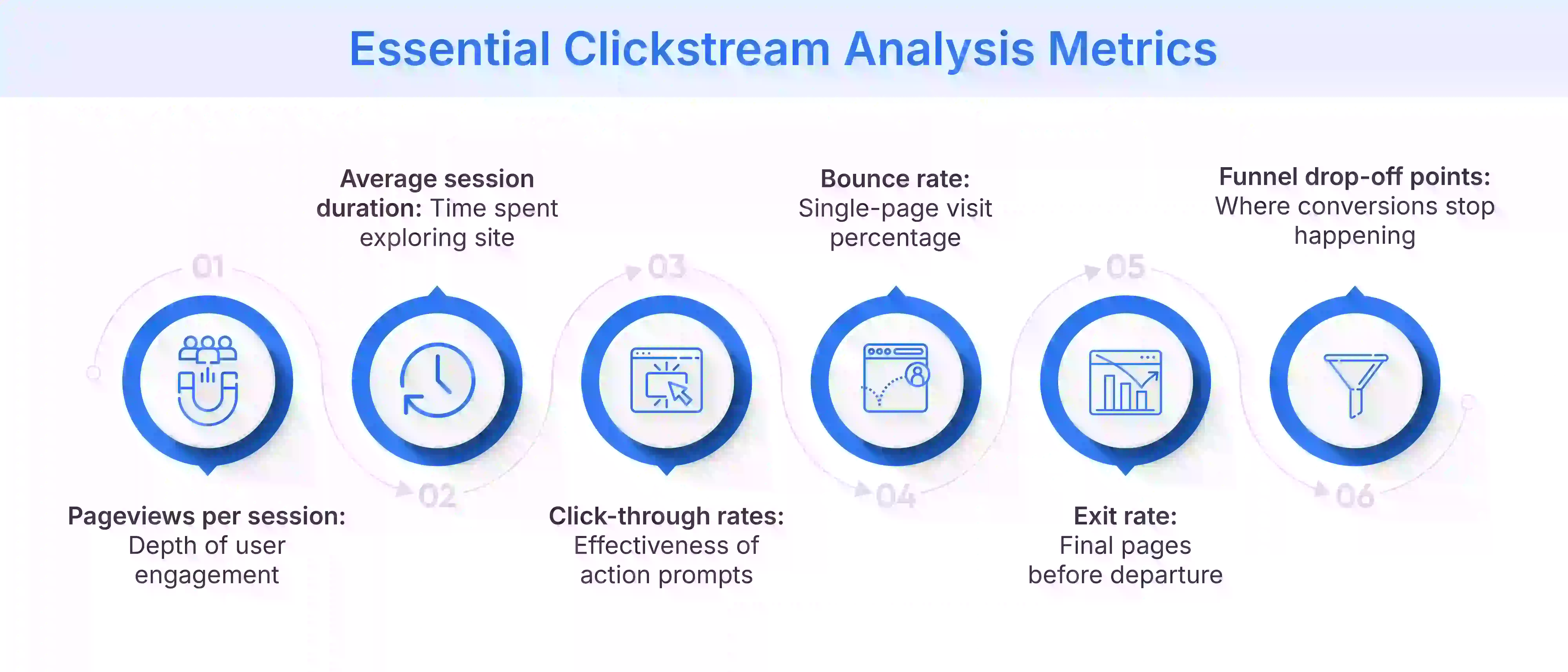Table of Contents
- What is Clickstream Analysis?
- Why is Clickstream Analysis Important?
- How Does Clickstream Data Analysis Work?
- How is Clickstream Data Collected?
- Clickstream Data Examples
- What Are the Key Metrics in Clickstream Analysis?
- How Can Clickstream Analysis Enhance E-Commerce Marketing Strategy?
- Conclusion
What is Clickstream Analysis?
Clickstream analysis is the process of tracking and recording a user’s journey across digital platforms. This method collects data on every action a visitor takes, from their entry point to their exit. Analyzing this detailed digital trail reveals precisely how users navigate a website and engage with its content and features.
Clickstream analysis helps businesses understand user behavior by:
- Observing the exact sequence of pages visitors view during a session.
- Determining the time users spend on specific content or product pages.
- Analyzing how visitors interact with buttons, links, or other elements.
- Identifying common paths users follow through the site's navigation.
- Pinpointing moments where users show high engagement or drop off.
Why is Clickstream Analysis Important?
Clickstream data offers valuable insights for building comprehensive customer profiles for businesses. It enables the combination of these detailed behavioral insights with other available data sources to provide a complete understanding of individual customers.
Optimizing Customer Journeys
Clickstream Analysis maps the complete path users take through digital platforms, highlighting successful conversion routes and identifying where improvements can be made for improved customer experience. Retailers can discover which product pages consistently lead to purchases, and which promotional content effectively draws users deeper into the sales funnel. This sequential understanding of the raw data enables strategic placement of high-performing content at critical decision points.
Exposing Points of Friction
Through Clickstream Analysis, retailers can identify exact moments where users abandon their journey or hesitate before continuing. These friction points might include complicated checkout processes, slow-loading pages, or confusing navigation elements that frustrate potential customers. By pinpointing these obstacles, companies can implement targeted fixes that maintain customer momentum toward conversion.
Creating a Customer 360 View
Clickstream data enriches the customer profiles by adding behavioral context to demographic information. Retailers can combine browsing patterns, purchase history, and engagement metrics with CRM data to develop a comprehensive customer understanding. This holistic view reveals preferences, habits, and decision-making patterns that static profile information alone cannot provide, enabling personalized retail experiences.
Optimizing Conversion Funnels
Clickstream Analysis dissects each stage of the conversion process, from initial product discovery to final purchase completion. Retailers can measure drop-off rates between funnel stages and test modifications to improve transition effectiveness. This methodical refinement process identifies which product recommendations, call-to-action placements, and checkout simplifications most effectively guide customers toward completed transactions.

How Does Clickstream Data Analysis Work?
Clickstream Data Analysis transforms raw navigation data into actionable business intelligence through a systematic process of collection, processing, and interpretation.
- Data Collection: Retailers gather raw clickstream data as users interact with their website or application. This process records every click, page view, and action performed by visitors.
- Data Processing: Raw clickstream data is cleaned, filtered, and organized into a structured format. Irrelevant data is handled and the dataset is prepared for subsequent analysis phases.
- Data Storage: Processed clickstream data is stored in databases or data warehouses built for scale. This ensures the structured data is easily accessible for analytical tools and queries.
- Analysis and Modeling: Analytical techniques and potentially machine learning models are applied to identify key patterns. Retailers look for significant customer trends in user navigation paths and overall behavior.
- Reporting and Visualization: Findings are presented through comprehensive reports, dashboards, or visual charts. Actionable insights are shared with relevant stakeholders for informed decision-making.
How is Clickstream Data Collected?
Businesses can collect user clickstream data through the following methods:
- Tracking Pixels: Tiny, invisible image files are embedded on web pages that retailers want to monitor effectively. These pixels are deployed easily.
- Cookies: Small data pieces are stored on the user's web browsers to remember them. Companies identify returning visitors and track sessions efficiently using cookies.
- Server Logs: Web servers automatically record every request they receive from visitors. Retailers gain detailed, raw access data from these logs.
- JavaScript Tags: Code snippets embedded in pages are used to send data directly to analytics platforms. These tags are deployed for a flexible tracking setup.
- Session Recording: Visual recordings of user screen activity and mouse movements are captured. Businesses can see actual user interactions play out live or in replays.
Clickstream Data Examples
Clickstream Analysis tracks various user interaction data points across digital platforms:
- Navigation Sequences: You can monitor the exact order of pages visited during a session, revealing common pathways to purchase or points where users frequently backtrack. This type of data helps optimize site architecture and product categorization to match natural shopping patterns.
- Search Queries: Every search term users enter provides insight into their intentions and specific product interests. You can identify trending search terms, commonly misspelled products, and searches yielding no results to improve inventory planning and site searchability.
- Add-to-Cart Actions: These crucial conversion steps record when items move from browsing to potential purchase. You can analyze which product pages, promotional displays, or recommendation engines most effectively trigger this commitment action.
- Checkout Abandonment Points: This data pinpoints the exact step where customers leave the purchase flow. You can identify whether shipping costs, account creation requirements, or payment options are causing significant revenue loss.
What Are the Key Metrics in Clickstream Analysis?
Clickstream Analysis relies on several core metrics to evaluate digital performance:
- Pageviews per session measures engagement depth, indicating how many product or content pages users typically explore before leaving.
- Average session duration reveals overall site stickiness and helps identify both positive engagement and potential navigation difficulties.
- Click-through rates (CTR) show the effectiveness of call-to-action elements, determining which prompts successfully drive desired user actions.
- Bounce rate identifies the percentage of single-page visits, highlighting potential landing page issues or misaligned marketing messages.
- Exit rate reveals which specific pages most commonly serve as the final touchpoint before users leave your site.
- Funnel drop-off points measure percentage decreases between sequential conversion steps, exposing weak links in your sales process.

How Can Clickstream Analysis Enhance E-Commerce Marketing Strategy?
Clickstream analysis allows businesses to refine how they reach and engage potential and existing customers online through several key applications:
- Personalized Experiences: By analyzing user browsing history and click paths, clickstream data analytics enables retailers to display relevant product recommendations and tailor content or offers to specific customer segments effectively on their sites.
- Improved Audience Targeting: Clickstream data collection and analysis helps businesses identify user groups with similar online behaviors or interests. This enables them to deliver more targeted advertisements and promotions across various channels, thereby increasing marketing campaign efficiency and ROI.
- Campaign Performance Optimization: Retailers track visitor behavior originating from campaigns to understand engagement and drop-off points. This insight from clickstream analysis facilitates data-driven adjustments, continually improving campaign results and overall effectiveness.
- Enhanced Marketing Effectiveness: Leveraging clickstream insights ensures marketing efforts become more relevant and efficient for the target audience. This strategic use of conversion data ultimately drives desired user actions and increases conversion rates across the platform.
Conclusion
Clickstream analytics is a powerful tool in modern e-commerce environments. It provides detailed, actionable insights into how customers interact with online platforms comprehensively. By tracking the digital footprint of users, businesses gain a deep understanding of their navigation patterns, preferences, and obstacles.
This crucial information effectively bridges the gap between raw customer behavior data and informed business strategy. Retailers make strategic decisions based on real user actions, resulting in enhanced online experiences, increased conversion rates, and ultimately, sustainable business growth.
FAQ
Clickstream analysis details the specific sequential path users take through a site, tracking every click and page view order. Traditional form of web analytics typically provides aggregated metrics, such as total visits or page views, without focusing on the granular, step-by-step user journey flow.
Businesses must address user privacy by anonymizing clickstream data to remove personal identifiers. Obtaining explicit user consent for tracking is crucial. Ensuring full compliance with relevant customer data protection regulations, such as GDPR or CCPA, is a key privacy consideration for implementation.
AI and machine learning significantly enhance clickstream analysis by identifying complex patterns to develop an accurate understanding of user behavior These technologies automate data processing tasks and uncover deeper, less obvious insights than manual analysis might reveal, improving predictive analytics.
Businesses integrate clickstream data with sources like CRM systems or transaction data. Combining behavioral data with customer profiles creates a comprehensive 360-degree view. This fusion provides a much deeper understanding of customer behavior and informs more effective targeted strategies.

